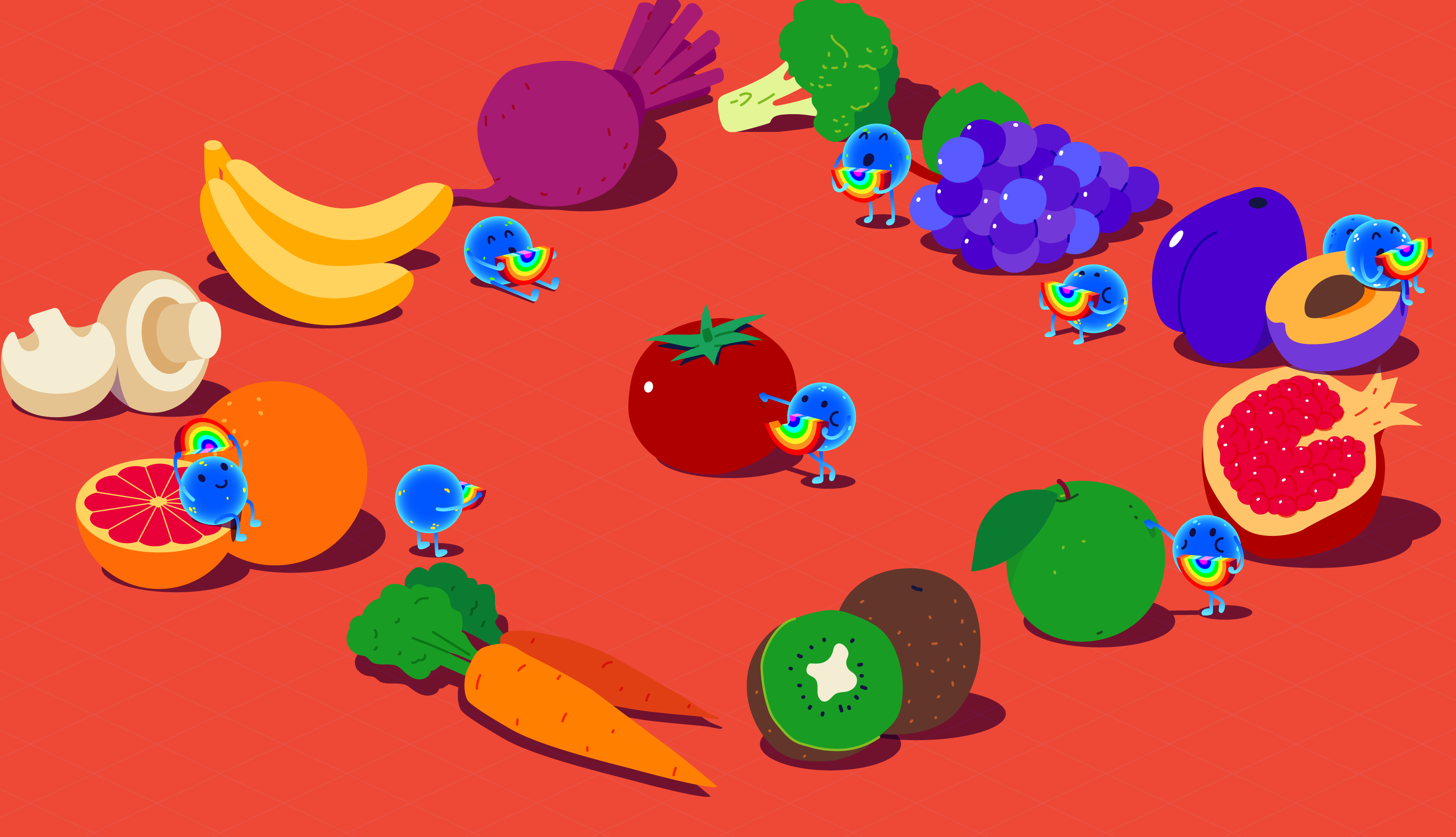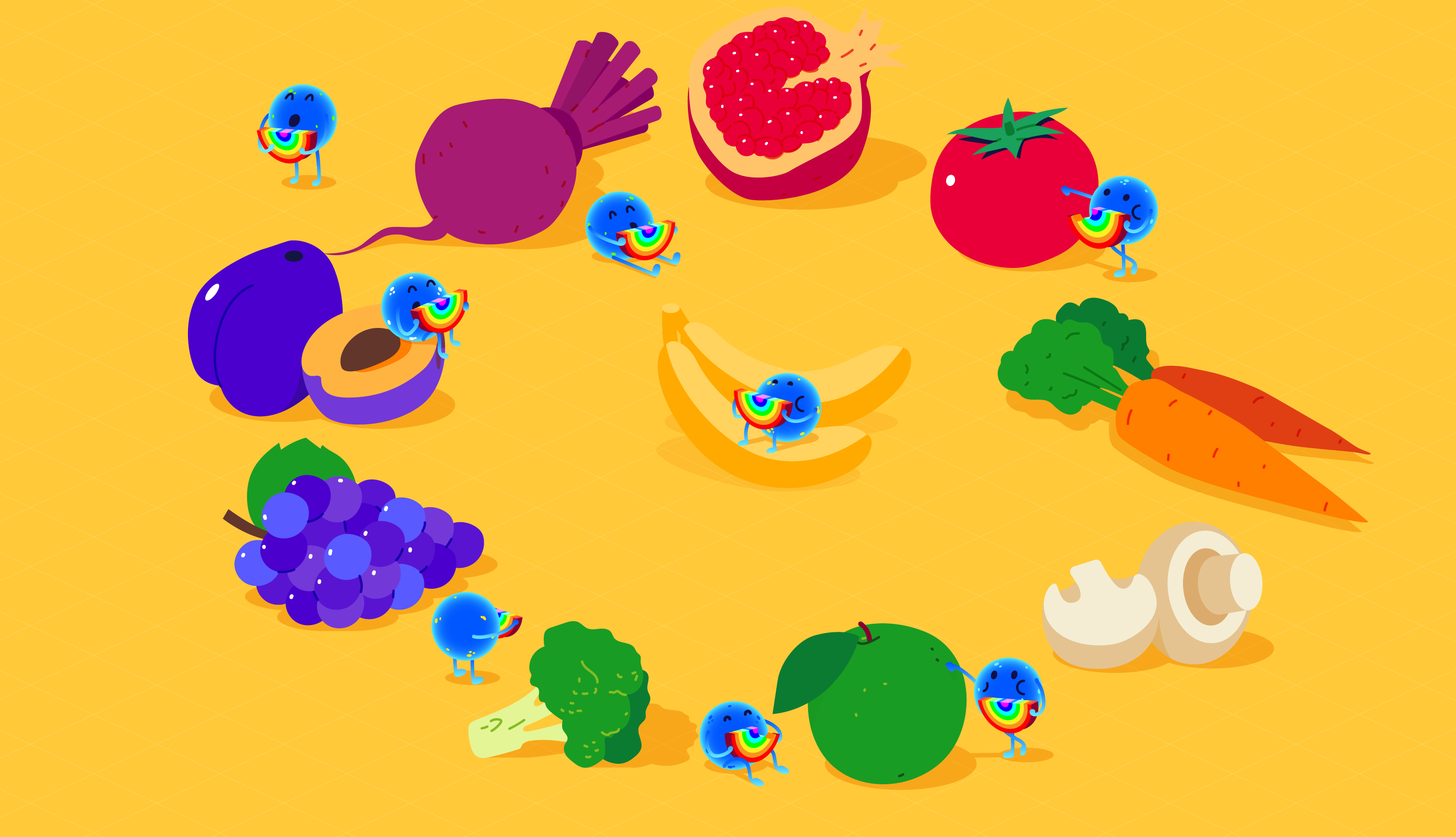Green foods contain an array of micronutrients and phytochemicals that support healthy blood flow, the cardiovascular system, and heart health.
Current advice states that you should eat five portions of fruit and vegetables per day. However, many fail to meet this recommended fiber intake. This has implications for your health because the body can’t function optimally without whole, plant foods.
Fortunately, a simple philosophy, called "Eat The Rainbow", can help you diversify your diet by consuming different coloured fruit and veg. These edible plants contain naturally-occurring phytochemicals that support your immune system and prevent chronic disease.
Table of contents
- What is "Eat the Rainbow"?
- Green foods for heart health
- Phytochemicals in green foods
- Green vegetables and recipe ideas
- Green fruit and recipe ideas
Food should be a pleasurable experience, not a chore, so we’re giving you the facts about the five colours of the rainbow alongside some mouth-watering recipes. And this time, it’s the turn of the green foods.
What is "Eat the Rainbow"?
Red, orange, yellow, green, and blue/purple are the five colours of the food rainbow and each one contains phytonutrients with specific health functions.
If you think eating the rainbow means gobbling a load of multicoloured sweets, then you are quite mistaken. Instead, we’re talking about the vibrant plant's mother nature intended for us to eat. That’s right, plant-based foods like fruits and vegetables have many health properties.

Have you ever wondered why plant foods are so vibrant and appealing? Well, these pigments serve many purposes. For a start, these colourful pigments are attractive to other species, including human beings, who think they look good enough to eat. And then there are the bees who pollinate the plants by the power of colour (fun fact - bees love the colour blue).
These pigments aren’t just for show, they also serve as defence mechanisms. For example, some of the pigments deter invaders from eating them by releasing antibacterial solutions and bitter tastes to put them off. The health benefits of plant foods come from these phytochemicals, notably their potential for disease prevention.
When it comes to green foods, their naturally-occurring nutrients are renowned for their ability to support several different aspects of heart health. You’ve probably already heard of polyphenols and their antioxidant powers, but there are others too!
Polyphenols are the micronutrients that occur naturally in edible plants that are good for the body and your gut microbiome. Read about them here.
What is oxidative stress?
If your body has an imbalance between free radicals and antioxidants, then it is experiencing oxidative stress. Eating the right foods is the best way to combat it.
When there are too many free radicals for your body to deal with, they overwhelm its natural repair system. Therefore, oxidative damage is to blame for many chronic illnesses. Reactive oxygen species also contribute to ageing (and the gradual tissue and organ function degeneration that comes with it).
So, when there is an imbalance, the free radicals begin damaging DNA, proteins, and fatty tissue which make up a major part of the human body. Damage to these leads to disease. Fortunately, antioxidants (like those found in rainbow foods) can donate an electron to lonely free radicals, thus preventing oxidative stress and cellular damage.
☝FACT☝The body naturally produces free radicals as a result of exercise and inflammation. When balance is maintained, it’s a healthy function.
Green foods for heart health
Green foods are beneficial for your heart and blood pressure. So, if you want a healthy ticker, eat natural green stuff.
The heart is a major part of your circulatory system (but you already know that, right?). It’s about the size of a fist and it pumps blood around the body, sending oxygen and nutrients to the areas that need it, and transporting waste (like CO2) to the lungs so that it can be removed.
Oxidative stress promotes high blood pressure, atherosclerosis (the narrowing of the arteries), and cardiovascular disease, all of which are serious conditions that increase the risk of heart attacks and strokes.

The good news is there’s plenty you can do to help your heart, starting with your diet. A diet rich in fruit and vegetables, the foods nature intended us to eat, has a protective effect against cardiovascular disease, lowers blood pressure, and prevents strokes.
Green foods are abundant in nutrients that are beneficial for heart health, like vitamin K, magnesium, nitrates, and folates. Dark leafy greens (the types you probably hated as a kid) have a high level of polyphenols which have antioxidant properties.
Phytonutrients in green foods
These phytonutrients may be hard to pronounce, but don’t let semantics get in the way of eating the plant rainbow.
The phytonutrients in green foods include flavonoids which have antioxidant properties and help to protect the heart from disease. There are also nitrates, another plant nutrient associated with a reduced risk of cardiovascular disease mortality.
Phytonutrients in green foods
| Phytonutrients in green foods | |
|---|---|
| Catechins | Chlorophyll |
| Flavonoids | Folates |
| Isoflavones | Nitrates |
| Phytosterols | Tannins |
Nitrates and heart health
Research shows that dietary nitrates could be beneficial for both blood pressure and heart health. Foods rich in nitrate include leafy greens, like spinach, and cruciferous veg, such as broccoli, Brussels sprouts, and cabbage.
In large amounts, nitric oxide can be harmful, but it has an important role in protecting the body, too. For example, in the circulatory system, nitric oxide tells the muscles cells around the arteries to relax which helps to regulate blood pressure.
It’s important not to get mixed up with nitrates and nitrites though. Nitrites are added to processed meats, like sausages, bacon, and ham (some good old western faves), to enhance colour, flavour, and prevent bacteria growth – in large quantities, these can be toxic.
Green vegetables and recipe ideas
If you squirm when you hear the phrase "healthy food", fear not, we have some creative recipe ideas to boost your health and make you fall in love with green veg.
| artichokes | avocado | bean sprouts |
| bell peppers | broccoli | cabbage |
| celery | edamame | green beans |
| green peas | beet greens | kale | green chard | mustard greens | spinach | mustard greens | okra | watercress |
Make you and your loved ones an appetizer party with these amazing dips and crunchy bites that are packed with delicious green goodness to finally prove that green foods are truly the ambrosia of the gods.
Watercress has huge antioxidant potential and has a high chlorophyll content that is thought to help prevent heart disease. Why not try this flavoursome watercress soup by David Lebovitz. It’s a delicious green soup which uses potatoes to give it texture rather than cream.
If you love Asian cooking, then try sprouting your own mung bean sprouts: they’re a great source of nutrients, protein, and antioxidants, and also really simple to grow too. So simple in fact, you’ll probably wonder why it’s taken you so long!

If you buy guacamole, you might be surprised at how easy it is to make your own. This recipe is for spicy homemade guacamole. Avocados are packed with phytochemicals like carotenoids and phytosterols that are beneficial for heart health, so stop buying and start making.
Try this amazing, delicious, and healthy oven-baked spinach and artichoke dip. You could even pair it with the guacamole above. Both are great for dipping crunchy veg, the perfect mid-afternoon snack. You can customise it by substituting the spinach for any green leafy veg, or using a mixture of them for even more variety.
Stuck in and planning a Netflix binge? Look no further than these crunchy oven okra bites. A common staple in the American Deep South, okra is known to have heart health benefits and even anti-cancer properties.
Green fruit and recipe ideas
Some people find the colour green quite boring, but there’s nothing dull about these green fruits. And we’ve even put some scrummy recipes together for you to try too.
Green fruit table
| Green tea | Green apples | Kiwi |
| Limes | Olives | Pears |
Okay, fine - olives might not seem like a fruit, but technically, scientists have determined that they are a fruit (even though they are not traditionally sweet). Try this olive tapenade spread on your sourdough bread or as an alternative to tomato passata on pizza.
If you’re looking for a refreshing change to hot tea, then this cool, minty, citrusy, and honey-sweetened iced green tea is perfect, refreshing, and brimming with antioxidant goodness.

When you wake up, kick off your day with a beet, apple, and pear smoothie. It’s seriously crammed full of antioxidants and flavour and inspired by Indian cooking. You can even mix it up a bit by experimenting with different fruit and veg combos.
And if you needed an excuse to add some probiotics to your diet, then this yoghurt and lime sorbet with a hint of vanilla is a perfect dessert. Probiotics and phytonutrients, it doesn’t get much better than that, does it?
Head back to your childhood with deserts your grandparents would love, but with a cheeky adult twist. These cider-poached pears use spices for zing and less sugar than traditional recipes. Pears are a rich source of phytochemicals and antioxidants, and are naturally sweet. They’re even associated with a lower incidence of type II diabetes and stroke.
☝TIP☝Track and rate your meals for microbiome health with the Atlas Microbiome Test and the Atlas app.
- Dreher, M, L and Davenport, A, J. Hass Avocado Composition and Potential Health Effects, 2013
- Hord, N, G et al. Food Sources of Nitrates and Nitrites: The Physiologic Context for Potential Health Benefits, 2009
- Liguori, I et al. Oxidative Stress, Aging, and Diseases, 2018
- Minich, D, M. A Review of the Science of Colourful, Plant-Based Food and Practical Strategies for "Eating the Rainbow", 2019
- Moncada, S and Higgs, E, A. Nitric Oxide and the Vascular Endothelium, 2006
- National Health Service Inform. Understanding How Your Heart Functions, 2020
- Pignatelli, P et al. Oxidative Stress and Cardiovascular Disease: New Insights, 2018
- Reiland, H and Slavin, J. Systematic Review of Pears and Health, 2015



















